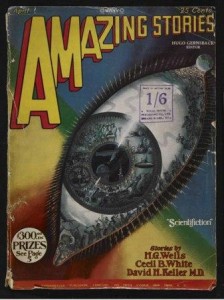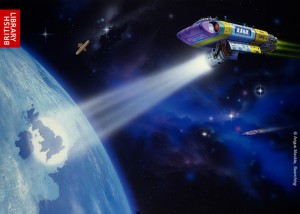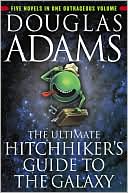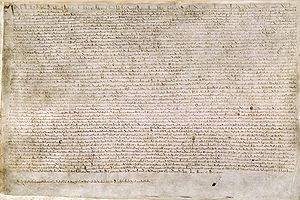 The British Library has just opened an exhibition on the history of science fiction. I had to read the article twice just to prove to myself it was real. The exhibition is called “Out of this World: Science Fiction but not as you know it” The exhibit will be running through 25 September 2011, for anyone who has a chance to visit London.
The British Library has just opened an exhibition on the history of science fiction. I had to read the article twice just to prove to myself it was real. The exhibition is called “Out of this World: Science Fiction but not as you know it” The exhibit will be running through 25 September 2011, for anyone who has a chance to visit London.
Besides the images from the early science fiction pulp magazines, which are incredibly awesome, there is a lot on the blog and in the exhibit about science fiction as literature. science fiction is a literature of ideas, after all. As a concept, it’s been around for a couple of centuries, depending on how one defines it. Jules Verne and H.G. Wells were writing science fiction, among other things. So was Lewis Carroll. And Mary Shelley–what is Frankenstein if it isn’t science fiction? The exhibit traces SF back to writings in the 17th century!
 Science fiction has always looked at other worlds. Either worlds in the future, alien worlds, virtual worlds, parallel worlds, perfect worlds, or apocalyptic worlds. Those are the themes described in the exhibit, with covers from the pulps or illustrations from classic novels to match. But the fact is that modern SF subgenres derive from those original themes; future world stories are now hard sf, alien worlds are space opera, virtual worlds are cyberpunk, parallel worlds are alternate history, perfect worlds equal utopian, and apocalyptic worlds are post-holocaust novels. Someone else’s mileage may vary on definitions, but the principle holds.
Science fiction has always looked at other worlds. Either worlds in the future, alien worlds, virtual worlds, parallel worlds, perfect worlds, or apocalyptic worlds. Those are the themes described in the exhibit, with covers from the pulps or illustrations from classic novels to match. But the fact is that modern SF subgenres derive from those original themes; future world stories are now hard sf, alien worlds are space opera, virtual worlds are cyberpunk, parallel worlds are alternate history, perfect worlds equal utopian, and apocalyptic worlds are post-holocaust novels. Someone else’s mileage may vary on definitions, but the principle holds.
The history of SF is all around me in this room, too. We re-shelved through the letter H over the weekend. Isaac Asimov’s Foundation trilogy is here. One of the surviving space operas. It’s a story that transcended its original time to become a cornerstone of the genre. Also, Asimov’s Complete Stories is here, which includes his 3 laws of robotics somewhere in there. Every robot story since has dealt with those laws in some way, either to use them or to flout them.
Ray Bradbury is shelved in the next section, so there’s Fahrenheit 451 along with a thick volume of his stories. Can anyone who loves books ever forget the power of that story?
 On the very first shelf, Douglas Adams’ Hitchhiker’s Guide to the Galaxy rests along with the other books in the series. True humor in science fiction is really hard to do well. The Hitchhiker’s Guide was a incredible accomplishment. Every once in a while, someone can catch that lightning in that bottle.
On the very first shelf, Douglas Adams’ Hitchhiker’s Guide to the Galaxy rests along with the other books in the series. True humor in science fiction is really hard to do well. The Hitchhiker’s Guide was a incredible accomplishment. Every once in a while, someone can catch that lightning in that bottle.
Way, way, way, too many years of The Year’s Best Science Fiction, edited by Gardner Dozois. I only say too many because each volume is positively huge. They take up two shelves, all by themselves.
 Harlan Ellison is here, with so many Dangerous Visions. Some Robert A. Heinlein, but I kept only the good stuff. There’s a lot of Frank Herbert, and I still have a copy of Dune from when it was published by Chilton. Yes, Chilton was the original hardcover publisher back when no one else would touch it.
Harlan Ellison is here, with so many Dangerous Visions. Some Robert A. Heinlein, but I kept only the good stuff. There’s a lot of Frank Herbert, and I still have a copy of Dune from when it was published by Chilton. Yes, Chilton was the original hardcover publisher back when no one else would touch it.
At the same time, there are newer books in here as well. A lot of Eric Flint’s 1632 series. Alternative history is still considered science fiction, mostly because it isn’t anything else. Kage Baker’s Company series, which is a combination of time travel and alternate history.
 But I can’t get over the idea that the British Library is doing a major exhibition on the history of Science Fiction. The BL is a place I associate more with the Magna Carta than Orson Scott Card!
But I can’t get over the idea that the British Library is doing a major exhibition on the history of Science Fiction. The BL is a place I associate more with the Magna Carta than Orson Scott Card!
